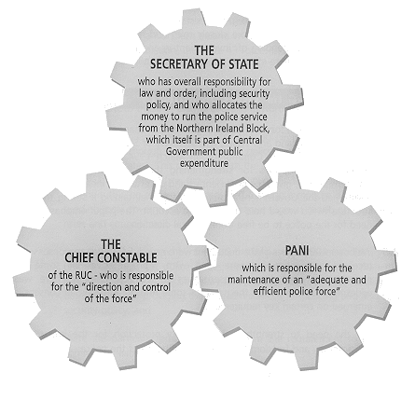|

CAIN Web Service
Foundations for Policing: Proposals for Policing Structures in Northern Ireland - Section 2
[CAIN_Home]
[Key_Events]
[Key_Issues]
[Conflict_Background]
Page Compiled: Fionnuala McKenna
Material is added to this site on a regular basis - information on this page may change
2: STRUCTURES FOR THE FUTURE
CURRENT ARRANGEMENTS - THE PROBLEMS
| 2.2 | The existing tripartite policing structure in Northern Ireland involves:
- the Police Authority
- the Chief Constable of the RUC
- the Secretary of State

|
| |
| 2.3 | The present arrangements have suffered from a number of problems which have led to inefficiencies in service delivery and reduced confidence in the police service. These include:
- confusion about the respective roles of the three parties leading to duplication and unnecessary bureaucracy;
- uncertain lines of accountability;
- the Police Authority is responsible for the administration of police resources, but has little influence over their deployment;
- the Police Authority is charged with expressing the views of local people, but has no formal mechanism for ensuring that these are taken account of by the police;
- the Chief Constable is responsible for operational matters but does not have management control of the resources he needs to carry out this responsibility'. and
- the lack of information presently available to the public on the way in which the Police Authority is appointed and operates diminishes public confidence in the Authority's ability to express community views.
|
| |
| 2.4 | There is thus a need to reform the existing structures so as to clarify lines of accountability, to define more closely roles and responsibilities, seek greater community understanding of, involvement in and identification with policing and to allow the more effective deployment of policing resources.
|
| |
THE "POLICING IN THE COMMUNITY" CONSULTATION
| |
| 2.5 | To take this reform forward, and recognising that changes were being made in structures in England and Wales, the Secretary of State issued a consultation paper "Policing in the Community" in March 1994. The paper set out the Government's proposals for strengthening the framework for policing in Northern Ireland, given the inefficiencies and uncertainties inherent in it. It also re-affirmed the Government's commitment to maintaining a strong tripartite structure which would hold the police to account. The paper emphasised the need for the police to be free from political direction.
|
| |
| 2.6 | Well over 1000 copies of the document were issued; 54 written responses were received and meetings were held with representatives of some 30 organisations, including representatives of political parties. There was widespread agreement on the need for some reform, and a broad consensus emerged on certain key requirements:
the need to strengthen the statutory protection for the impartiality, integrity and freedom from partisan influence of the police;
the maintenance of a tripartite structure, including a robust Police Authority;
the need to create stronger and more effective statutory accountability mechanisms;
the development of more effective dialogue between the police and the community; and
the need to make more efficient and effective use of resources.
|
THE WAY AHEAD
| 2.7 | Policing arrangements in England and Wales were extensively reformed by the Police and Magistrates' Courts Act 1994. The approach taken in England and Wales was carefully considered for its applicability to Northern Ireland as in many respects the Police Authority for Northern Ireland performs a similar role to that performed by the old police authorities in England and Wales, upon which it was originally modelled. PANI is charged with securing the maintenance of an adequate and efficient police force and, subject to the approval of the Secretary of State, determines the size of the police force, provides it with equipment, buildings and civilian support staff and administers its finances. However, there are significant differences in the arrangements in Northern Ireland:
the RUC remains a Northern Ireland wide force - a single police force for a single legal jurisdiction; there are 43 forces in England and Wales and 8 in Scotland;
the powers and responsibilities of local authorities in England and Wales are different to those of district councils in Northern Ireland;
in Northern Ireland all funding for the police is provided by Central Government (though a percentage of policing costs is notionally levied against local rates). This contrasts with the position in England and Wales where the Home Office provides just over 50% of estimated police expenditure. The remainder is provided through a mixture of systems for funding local government services - revenue support grant, non-domestic rates and council tax;
the circumstances faced by the RUC in the past quarter of a century are unique amongst UK police forces; unlike all GB forces (other than the Metropolitan police) the Secretary of State has the sole responsibility for determining and providing the overall resources for policing and also sets security policy; and
there are particular problems arising from the requirement to police a community with deep political divisions.
|
| |
| 2.8 | The Government has, therefore, developed proposals for Northern Ireland which draw substantially upon the arrangements in the Police and Magistrates' Courts Act, but take account of the special factors affecting Northern Ireland.
|
Return to Publication Contents
|

